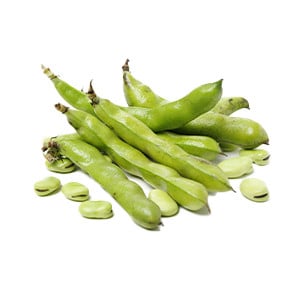Bean (Broad bean / Faba bean / Field bean)

Bean (Broad bean / Faba bean / Field bean)
Vicia faba
Plant family
Legumes (Fabaceae)
Also known as
Fava Bean, Tic Bean, Tick Bean, Horse Bean
Season Overview
Sowing
Harvest
J
F
M
A
M
J
J
A
S
O
N
D
Details
Light requirement
Sunny
Water requirement
Wet
Soil
Medium (loamy)
Nutrient requirement
Medium
Plant distance
10 cm
Row spacing
60 cm
Seeding depth
5 cm
Instructions
The season for this plant has not yet begun. The following instructions are for the beginning season.
End of October
Sowing
Mid of November
Support
Mid of November
Mulch
Description
The field bean (also called broad bean, cattle bean, broad bean, or broad bean) belongs to the legume family. This makes it a good precursor crop for nutrient-demanding crops. Its deep roots go into symbiosis with nitrogen-fixing bacteria and nitrogen is enriched in the soil. Even though it is called field bean, it does not belong to the beans, but to the genus of vetches. The field bean is not particularly sensitive to frost - on the contrary, a cold stimulus promotes its germination. Therefore, it is suitable for locations where many beans are already too cold. Usually summer field beans are planted, but there are also winter field beans, these can be sown as early as autumn. They ripen 1-2 weeks earlier than summer field beans and thus cope somewhat better with early summer - drought.
Origin:
It originates from the Mediterranean region.
Growing tips
When growing field bean, you can remember one thing: sow early and deep! Too late sowing often leads to aphid infestation and gives a head start to undesirable weeds. A deeper sowing has a positive effect on the stability. Direct seeding is possible from the end of February to the end of March. Alternatively, you can prepare cuttings from the end of January. After about four weeks you plant them out in suitable weather. Depending on the variety, it takes about 100 days until harvest. For a better stand you can pile up the plants. Otherwise they are very undemanding.
Companion Plants
Asparagus
Beetroot
Black salsify
Borage
Broccoli
Brussels sprouts
Cabbage (Cabbage)
Cabbage (Savoy cabbage)
Caraway / Meridian fennel / Persian cumin
Cauliflower
Celery (Celeriac / Celery root)
Celery (Celery)
Collard greens (Kale)
Collard greens (Tuscan kale / Dinosaur kale / Palm tree kale)
Corn / Maize
Courgette / Zucchini
Cucumber / Gherkin
Dill
Kohlrabi / German turnip / Turnip cabbage
Lettuce (Radicchio / Italian chicory)
Napa cabbage / Chinese cabbage
Nasturtium
Pak Choi
Potato
Pumpkin / Squash
Radish
Rhubarb
Rutabaga / Swedish turnip
Savory
Spinach (Summer)
Sweet potato
Tarragon
Turnip
Antagonistic Plants
Diseases
Ascochyta blight
Pests
Black bean aphid
Pea leaf weevil
Broad Bean weevil
Land snails